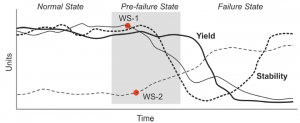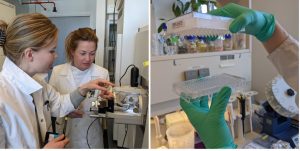The algae-eating microbiome that lives inside an anaerobic reactor
The world is in desperate need of energy sources beyond today’s fossil fuels. In one of the more promising renewable energy systems, oxygen-free, or so-called anaerobic reactors are used to produce biogas, which can be utilized as bio-based fuel. The key component of such reactors is the microbiome – a community of microorganisms that live and work together. They break down organic matter such as algae into a variety of smaller compounds including fatty acids, proteins and lipids, and further convert these degraded products to methane and carbon dioxide.

Fig. Anaerobic reactors fed with microalgal biomass (Scenedesmus sp.)
Despite their potential, anaerobic reactors often undergo process instability over time, making the system vulnerable to outside perturbations, and with potentially huge economic consequences for large-scale industrial production. Thus, optimal performance of the anaerobic reactor needs to be ensured through failure prediction of the system, and we will address this utilizing sophisticated mathematical modelling and strict monitoring of the microbiome and its function over time, and through perturbations.


Fig. Mathematical modelling to detect reactor failure
NMBU’s core expertise is analyzing microbiomes, detecting what types of microorganisms are present and how they collectively work together to drive the necessary metabolic processes, within the reactor. By analyzing the molecules that constitute microorganisms, such as their DNA and proteins, we can determine which microbes that are involved in all the major metabolisms, including fermentation, acetogenesis, and methanogenesis. To accomplish this task, we are using state-of-the-art techniques and equipment, including both DNA sequencers and a recently acquired super-sensitive mass spectrometer (http://www.napi.no/) for analyzing microbial proteins.

Fig. Mass spectrometry and DNA prep
The technology, otherwise known as multi-omics, combines both metagenomics and metaproteomics, and is a fascinating way to draw a comprehensive picture of how the microbiome eats algae and produces methane. The knowledge generated will be sufficient to detect a pre-failure state and would facilitate the development of full-scale anaerobic reactor systems capable of coping with real-life perturbations and producing a stable biogas flow.
NMBU Team1:
JM Walter, LH Hagen, PB Pope, MØ Arntzen
1Faculty of Chemistry, Biotechnology and Food Science, Norwegian University of Life Sciences, Ås, Norway
Acknowledgement: This work has been funded by the European Union’s Horizon 2020 research and innovation programme under grant agreement No. 101007006 (PRODIGIO project). JMW acknowledges funding from the European Union’s Horizon 2020 research and innovation programme under grant agreement No. 101007006 (PRODIGIO project).
Article written by Magnus Arntzen (NORGES MILJO-OG BIOVITENSKAPLIGE UNIVERSITET).





